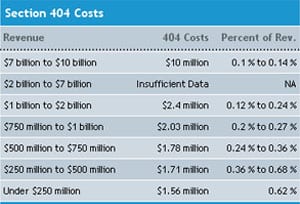As the full demands of complying with Sarbanes-Oxley become clear, companies are increasingly calling for help to rein in the costs.

|
|
|
The cost of complying with the controversial section, which forces companies to monitor the internal controls they have in place to ensure their financial reporting is accurate and requires outside auditors to vouch for those controls, can tally several million dollars for a mid-size company.
Although there is no formal movement to persuade Congress to revamp the legislation that was quickly pushed through in 2002 after financial scandals at Enron, WorldCom and others, the vociferous and constant complaints of companiesfrom giant multinationals to struggling start-upshas finally forced the US Securities and Exchange Commission (SEC) to react.
While carefully noting that the federal securities agency is only implementing legislation mandated by the US Congress, SEC officials have take a series of steps aimed at easing the burden on the most vulnerable companies and simply listening to the woes of executives now facing onerous compliance costs.
The most definitive step taken by the SEC to relieve the burden was its decision in early March to extend the compliance dates for Section 404 for small US companies and foreign firms by a year, to July 15, 2006. SEC spokesperson John Heine says the agency extended the deadline in order to make sure companies implement the rule correctly. We want to make sure that people are getting it right, he adds.
The extra time also gives smaller companies a chance to see what steps a newly created SEC commission might take to temper the compliance burden. Established in December, the SEC Advisory Committee on Smaller Public Companies will examine the impact that the Sarbanes-Oxley Act and other aspects of the federal securities laws are having on smaller firms. Early last month the SEC named the 19 additional members of the committee after announcing the co-chairs in December. SEC chairman William H. Donaldson said the committee would look at whether the costs for small companies of complying with the regulations are worth the benefits.
Another step aimed at quelling the complaints surrounding Section 404 is an SEC decision to hold a roundtable discussion at commission headquarters in Washington this month. Attendees can vent their complaints at the April 13 meeting, which is open to the public. The commission is also accepting written feedback from company executives, auditors, investors and other parties on their experiences in implementing the Section 404 rule.
As a way to counter the CEOs weight, firms are beginning to appoint a lead director of the board. This person does not have to be the board chairman but has the responsibility and power to monitor and challenge the decisions being made by the companys top management.
|
Conflicting Views |
|
Industry observers say its too early to tell whether the federal securities watchdog will take any specific actions to reduce the growing costs of compliance. Companies are laying out millions of dollars: salaries for new staff needed to handle the extra paperwork, outside auditors to ensure the proper internal controls are in place, fees for attorneys, information technology costs and printing costs. The list goes on.
I think the regulators are taking a step back and looking at the bigger picture, says Scott Cohen, editor of Compliance Week, a Boston-based newsletter on corporate governance and compliance issues. But its too early to tell if the burden will ease. The business community has been talking about the challenges and looking to pressure everybody that they can. David Chavern, director of the corporate governance initiative at the US Chamber of Commerce in Washington, says companies are not trying to change Section 404. No one is looking at repealing or altering Sarbanes-Oxley, but companies need more flexibility and better guidance in how auditing firms are reacting to the rules and standards, he says. Right now, the auditors are going overboard and interpreting everything in a conservative way in order to not come up short. Yet Scott Powell, a visiting fellow at the Hoover Institution at Stanford University in California, thinks Sarbanes-Oxley should be revamped in a manner similar to how the Securities Act of 1933 was reworked by the subsequent Securities and Exchange Act of 1934. Powell recently wrote a paper for the Hoover Institution titled Sarbanes-Oxley: A Cure Worse than the Disease? He says the 1933 legislation was passed in an environment similar to Sarbanes-Oxley, after market excesses such as conflicts of interest, accounting irregularities and fraud led to a market crash and subsequent calls for government intervention to protect investors. Powell believes that Congress can correct the overreach of Sarbanes-Oxley by making the Section 404 mandate on internal controls voluntary and letting company executives or shareholders determine the appropriate level of controls for their company. He says that less intrusive legislation would give shareholders and managers more say than the government in deciding how to spend corporate resources. It would also let company executives return to managing their businesses. Companies need to be outward looking and focus on newer and better products and services, says Powell. Complying with Sarbanes-Oxley has become a full-time job that forces management to take their eye off the ball. Daniel Oakley, director of knowledge management for Ernst & Youngs financial services practice, agrees. The unmeasurable costs are the opportunities that are lost because management is worrying about compliance and not running their business, says Oakley. Its dampening the entrepreneurial spirit. |
Costly, But Beneficial

|
Even with all the costs and energy being expended in executive offices on both sides of the Atlantic, Sarbanes-Oxley can still offer managers the proverbial silver lining. For the heads of corporate information technology departments, compliance with the myriad regulations of the law can provide the ammunition they need to persuade their top managers to purchase comprehensive enterprise resource planning systems.
Treasury departments are getting more support from top management on implementing more comprehensive platforms, says Thomas Bergqvist, chief marketing officer at Trema Group in London, a technology supplier to large corporations in the US and Europe. If you have four different systems, compliance is an extremely tedious process. Investing in a comprehensive system is sound risk management.
Les Stone, an executive based in the Boston office of Accenture, also sees ways in which corporations can use some of the regulations of Sarbanes-Oxley to improve their overall performance. The laws accelerated reporting requirements for corporate quarterly and annual financial results, for example, can be used by chief financial officers to get their financial information to Wall Street more quickly and earn a premium on their stock price in the process, says Stone, who is an associate partner in the consulting firms finance and performance management service line.
If youre going to spend all this money on compliance, companies need to learn how to manage the information and turn it into a good story that gives them a competitive advantage, says Stone.
Paula L. Green



